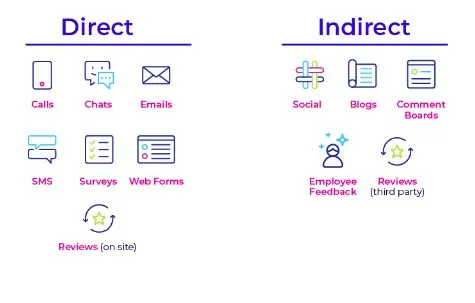Insights from customer experience (CX) analytics provide the data you need to run a more consumer-centric customer service department.
It gives you the information to know what matters most to your customers, what they are looking for from your products or services, and what actionable plans you can take to ensure acquiring and retaining loyal customers.
The problem is that organizations are discovering roadblocks due to unstructured data. Businesses recognize that 80% of their content is unstructured. This includes:
- Onboarding documents
- Work descriptions
- Emails
- Documents
- Research reports
- Legal documents
- Digital assets (i.e., video and images)
- Social media posts
Data silos, inefficient data collection and storage, and a lack of effective automation can make gleaning valuable insights from customers virtually impossible. What can you do to improve data collection for analysis?
Let’s take a moment to understand CX analytics and what these reports should contain. You will then learn how to effectively collect CX analytics for your analysis and what’s next in developing strategies based on these insights.
Key Takeaways:
- CX analytics consists of gathering and analyzing customer data for business strategy development and improved customer communications.
- Roughly 91% of customers will leave without warning if they have a negative CX with your organization.
- Determine what CX data is critical to your organization to enhance business strategies from insights from data points.
What Are Customer Experience Analytics?
Simply put, CX analytics is when an organization gathers and analyzes customer data. Customer data includes any methods your customers use to interact with your brand. It may include any of the following:
- Social media
- E-commerce
- Web chat
- SMS text
- Reviews
- Phone support
- Chatbot dialog
With these insights, you and your teams develop a better understanding of your customer’s journey throughout the buying process. That will allow you to highlight successes and make improvements where necessary.
The data you need to include in these reports includes title, statement of insights, customer verbatims, details, human elements, and success stories.
How to Collect CX Analytics
According to a study conducted by Finance Online, 91% of customers with a bad customer service experience will leave without warning. Nearly half (47%) switch brands and over a third (40%) recommend to their friends, family, colleagues, and acquaintances not to buy from that company.
Source: FinancesOnline
Customers deeply care when it comes to their experience with a brand. CX analytics helps you improve your products, services, and processes to better serve your customers by addressing their pain points. Here are the steps to collecting CX analytics:
1. Determine What CX Insights and Data You Need
The critical first step in CX analytics is identifying your company’s goals and what business strategies your teams will develop from this data. That will help you determine what CX insights you need to collect.
It may change based on demand and the size and scope of the strategy you’re developing. For instance, if your marketing team is creating a new ad campaign, you can analyze customer purchase and return history, product reviews, and comments from previous posts.
2. Identify the Channels Customers Use
There are two types of channels customers will use to engage with your organization, direct and indirect. Direct includes calls, chats, emails, text messages, surveys, web forms, and onsite reviews. Indirect channels include:
- Social media
- Blogs and press releases
- Comment boards
- Third-party reviews
- Employee feedback
Source: Khoros
It’s vital to identify which channel your customers use for two reasons. First, you must reach your customers where they interact most with your brand. That is paramount when addressing questions or concerns.
Secondly, you want to know what insights are available on that channel. For instance, if customers repeatedly ask questions on social media about how to use your products, you can develop a strategy to create some “how-to” content on your website as a blog, article, or guide.
3. Collect Data From All Channels
Now that you know what channels your customers use to connect with your brand, the next step is to collect and analyze data from every channel your customers use. If you don’t ensure the accuracy of this step, your data will be incomplete.
For instance, you don’t want to review only customer feedback from your company’s social media page and neglect to collect data from Google reviews customers leave on your Google My Business page or Yelp listing.
Analyzing CX Data
Next, you must determine what CX data is vital to your organization and the various business strategies you can develop from the insights from these data points. First, you must prioritize the channels your customers most commonly use.
Do your customers reach out using social media channels? Perhaps their preferred method is comment boards under your blog posts and press releases. Whatever their form of preferred communication, it’s essential that you meet your customers using their preferred channels.
Find points of friction within your organization. Begin with obvious insights, such as reviews.
Interact with customers regarding their concerns using a direct channel. If a customer leaves a negative review based on a bad experience, make sure that you address their comments and concerns.
Beyond interaction to improve CX, use the insights from those interactions to create actionable plans to resolve issues, determine more productive processes, and learn what customers are saying about a particular product or service so that you can make improvements as necessary.
Lastly, use metadata when analyzing CX data. This includes:
- Clickthrough data (website engagement)
- CRM data
- Personas
- Marketing insights
- Membership information
- Purchase history
Analyzing metadata can give powerful insights into your customer’s experiences with your brand without seeking further feedback.
For instance, if you notice a correlation between a specific product and why items get frequently returned, you can forward that data to the development team for product improvements.
What’s Next?
It may surprise you how quickly you can launch a CX analytics program within your organization. With the right marketing automation tools, you can glean valuable insights and develop better marketing strategies to reach your target demographic. With the right systems in place, you can have a fully operational CX analytics solution that offers measurable value on its ROI.
Are you interested in learning more about how MXTR’s automation tools can assist you with your customer experience analytics? Contact us today to start a conversation.
Featured Image: istockphoto









